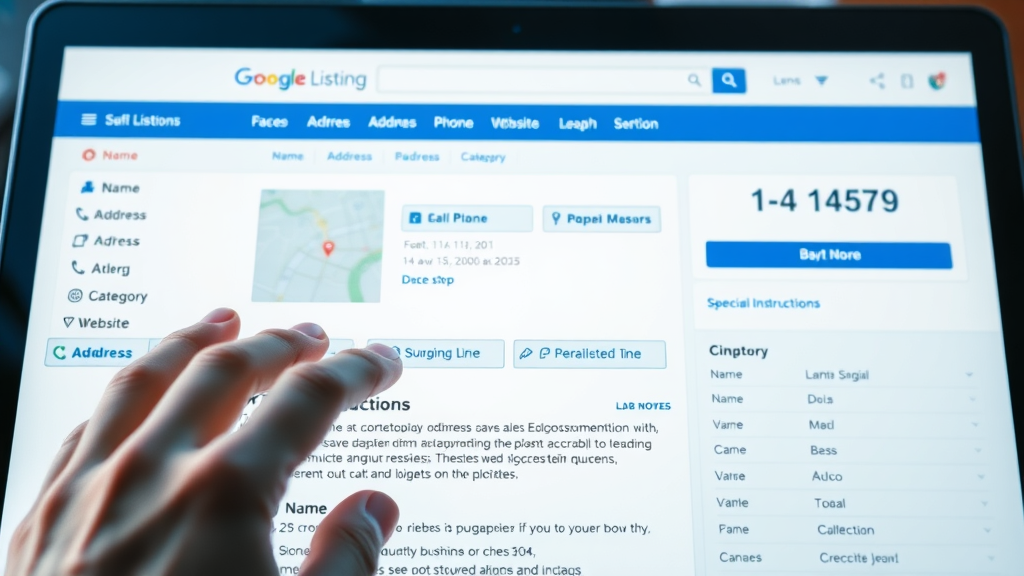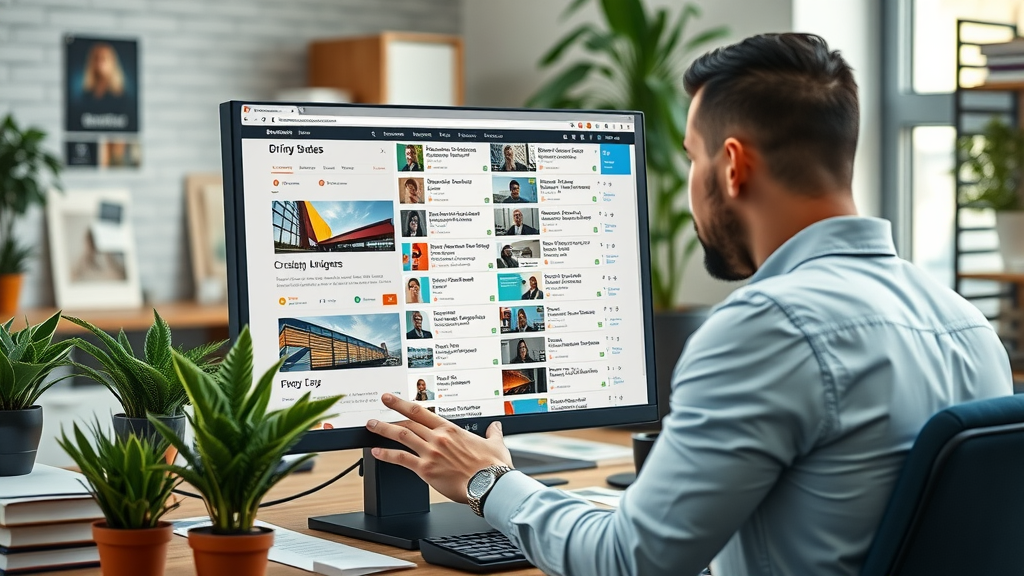Did you know businesses with consistent local citations are 70% more likely to boost their local search rankings within a year? If you’re eager to outpace competitors, build trust, and attract more local customers, understanding the power of local citations is your secret weapon. This guide breaks down how to leverage citation sources and strategies to fuel faster business growth—no technical jargon, just actionable insights!
Why Local Citations Are the Unsung Heroes of Local SEO
In the race for dominating local SEO and capturing relevant customer searches, local citations play a pivotal—yet often underestimated—role. A local citation is any online mention of your business's Name, Address, and Phone number (NAP) , typically found in business directories, local listings, or major platforms. When potential customers hunt for businesses “near me,” search engines cross-check your citation data to verify legitimacy and relevance.
For small businesses striving to enhance their local rank, citations build credibility and improve your visibility in local search results . Think of a citation as your digital business card: the more consistent and widespread it is, the easier it becomes for both search engines and customers to find—and trust—you. Consider practical examples: Imagine a bakery listed on Yelp, Google Business Profile, and Facebook. If all citations match, Google sees your business as reliable, rewarding you with better local search ranking. Inconsistent listings, on the other hand, can confuse search engines, leading to lost search opportunities and decreased online presence.

Local Citations and Local Search: Utilizing Data to Stand Out
The synergy between local citations and local search is simple: the more accurate and consistent your business listings across the web, the easier it is for search engines to validate your existence. With thousands of local businesses competing for attention, rich and reliable local citation data becomes a key differentiator. Search engines like Google, Bing, and Apple Maps consult authoritative sources—including business directories, review sites, and localized pages—to cross-confirm your NAP information before ranking your business in the “local pack.”
Utilizing structured citation data not only authenticates your business profile but also amplifies your reach. Using schema markup, ensuring up-to-date photos, and matching categories across directories provides search engines with additional signals—enhancing your local search rankings . By managing local citations vigilantly, smart business owners separate themselves from competitors relying solely on a single business listing or ignoring citation management altogether.
Local Citation Statistics: Revealing the Impact on Local Business Growth
Data tells a compelling story: Consistent business listings increase the likelihood of higher search rankings by 70% , while businesses with fragmented citation information experience up to 40% fewer customer interactions. For local businesses aiming to grow quickly, the numbers make a clear case for investing in strong local citation building. Studies also indicate that up to 78% of potential customers abandon a brand after finding inconsistent online information.
"Businesses with consistent local citations are 70% more likely to improve their local search rankings within a year."
These statistics reveal that managing citation sources systematically isn’t just an SEO trend—it's a lifeline for amplifying online visibility, attracting targeted leads, and building trust in your local market.
Understanding Local Citations: The Foundation of Local SEO Success
Every solid local SEO campaign starts with mastering the basics: what are local citations, and why are they so critical? Local citations refer to any references online to your business’s Name, Address, and Phone number —key data points collectively known as NAP. They can appear on major platforms like Google Business Profile, online directories, industry association pages, and even local news websites.
Establishing a network of accurate citation sources is fundamental. In essence, each citation boosts the chances for your business to get picked by search engines as a trusted, highly-ranked local result. By creating, standardizing, and expanding these local business profiles, you cement your position as a credible player in your market—essential for any business owner serious about rising above local competitors.
What Is a Local Citation? Core Elements and Common Formats
A core element of effective local citation building is understanding what constitutes a citation and the formats they take. At its heart, a citation includes your business name, address, phone number, business category, and often your website URL . This data is displayed across various online platforms—from local business directories to map listings and social platforms.
Local citations can come in a variety of formats, but the key to leveraging their SEO value is ensuring this information is consistent across all platforms. This allows search engines to trust the data and confidently recommend your business in local search results. For example, a restaurant listed with an accurate business name, correct address, and updated phone number on Google, TripAdvisor, and Facebook is much more likely to appear in local search packs and map results than one with outdated or mismatched listings.

Types of Local Citations: Structured vs. Unstructured
There are two primary types of local citations —structured and unstructured. Structured citations are found on business directories, review sites, and local listing platforms. These have organized fields for your NAP information, making it easy for search engines to scan and verify your business details. Examples include Google Business Profile, Yelp, and Yellow Pages.
Unstructured citations appear as mentions of your business in online articles, blogs, news stories, or even social media posts. These don’t necessarily have dedicated fields for NAP, but if your business information is displayed together (such as in an event summary or press release), it still counts. Both citation types play a critical part in building your online presence and boosting local search authority.
- Key elements in local citations: Name, Address, Phone Number (NAP), Business Category, Website URL
The Role of Local Citations in Local Search and SEO Citations
The relationship between local citations and local search rankings can’t be overstated. Search engines use citations as a tool to verify your business’s legitimacy and to decide where you land in search engine results pages (SERPs). The more credible, consistent, and relevant your citations, the more likely your business is to earn a prime spot in local ranking results.
Effective citation building covers both the quantity and quality of citation sources. To maximize your SEO citation efforts, you should focus on authoritative directories and niche-oriented platforms most relevant to your industry and local area. Skipping this step means missing out on a fundamental ranking signal for local SEO.
How Local Citations Influence Search Engine Rankings
Local citations directly influence search engine trust signals. When search engines find consistent NAP information across various citation sources, they are more confident placing your business high in search rankings. Inconsistent or duplicate information, however, can result in confusion—lowering your trust score and hindering your visibility in crucial local search results.
The goal is to achieve both breadth and depth: broad coverage across major business directories, and deep relevance in industry-specific and local platforms. Businesses that excel in citation building provide search engines multiple touchpoints for verification, making it easier to appear in the local pack and outshine competitors in SEO citation efforts.

The Connection Between Local Citations, Search Engines, and Local Search Rankings
Search engines like Google, Bing, and Apple Maps use citations as foundational data to determine the authenticity and prominence of a local business. The higher the volume and accuracy of your local citations , the more robust your visibility in local search rankings. This means your business is not only easier for customers to find but is also perceived as more trustworthy—a critical advantage in competitive markets.
Having comprehensive citation coverage also shields your brand against negative signals. When all your business information is synchronized, any discrepancies that might arise are easier to identify and rectify before they affect your search ranking or customer confidence.
Why Citation Source Matters for SEO Citation Quality
Not all citation sources are created equal. Citation quality plays a key role: being listed on high-authority directories and platforms boosts your local SEO citation impact significantly more than a scattershot approach on low-quality or irrelevant sites. Citation sources with high domain authority, regional influence, or industry standing will provide the strongest trust signals for search engines.
Focusing on reputable, relevant directories also minimizes the risk of inaccurate information being syndicated, which in turn reduces confusion and negative ranking signals. Smart citation building means being strategic about where and how often you list your business, rather than maximizing quantity alone.
Analyzing Citation Sources: Where to List Your Business
Choosing the right citation sources is a foundational element of local SEO citation success. While big-name business directories provide valuable domain authority and visibility, niche and hyperlocal platforms can propel your relevance within your service area. A balanced approach, tailored to both general and industry-specific directories, ensures broad citation coverage and deeper local ranking power.
For optimal results, focus on a mix of reputable business directories like Google Business Profile and Yelp, as well as trusted local Chambers of Commerce, professional associations, and area-specific online resources. These platforms offer rich opportunities for citation building and exposure to targeted local audiences.
Top Citation Sources: Business Directories and Beyond
While business directories such as Google, Yelp, Apple Maps, and Bing are obvious citation sources, don’t overlook the power of local blogs, sponsorship listings, association pages, and local event listings. Leveraging both structured business listing platforms and unstructured sources allows you to cast a wider net for citation relevance and trust.
Remember, the best citation sources for your business depend on both domain authority and content relevance. Prioritize those that have active moderation, industry focus, and frequent updates—these will typically weigh heavier in the eyes of search engines and potential customers alike.

| Directory Name | Domain Authority | Citation Source Quality |
|---|---|---|
| Google Business Profile | 99 | High (Crucial for local SEO) |
| Yelp | 95 | High (Prominent local business directory) |
| Apple Maps | 93 | High (Mobile-driven traffic) |
| 96 | Medium/High (Social presence) | |
| Yellow Pages | 91 | Medium (Traditional authority) |
| Industry Association Sites | Variable | High (Niche relevance) |
How to Build Local Citations: A Step-By-Step Guide
Establishing a robust local citation presence starts with knowing where you stand and ends with a commitment to ongoing maintenance. The following step-by-step guide simplifies the process for any business looking to enhance local SEO citation signals and soar above nearby competitors.
"The right local citation strategy can elevate your business above the competition in local search results."
Local Citation Building Checklist for Local Businesses
The backbone of local SEO success is a structured citation building process . Begin by auditing your existing business listings to root out inaccuracies and gaps. This forms the foundation of your citation building strategy, ensuring all new submissions start with correct information. Next, identify and prioritize the most authoritative local directories and niche platforms for your field—these offer greater weight with search engines.
As you work through this checklist, keep consistency at the forefront. Complete every business profile with thorough NAP details, business category, and a verified website URL. Regularly monitoring and updating your listings is not a one-and-done task; citation management is an ongoing responsibility for sustained search ranking gains.
- Audit current business listings
- Identify top local directories
- Ensure consistent NAP data
- Submit to niche citation sources
- Monitor and update citations regularly

Local Citations and NAP Consistency: Why Accuracy Drives Local Ranking
In the world of local SEO , NAP consistency is the linchpin of effective citation building. NAP stands for Name, Address, Phone number ; keeping this information exactly the same across all citations eliminates search engine confusion and maximizes your potential for local ranking improvements.
Accurate business listings allow search engines to aggregate and trust your business information, providing a clear pathway for higher search rankings. It also minimizes customer frustration—nothing erodes trust faster than encountering conflicting phone numbers or addresses online.
Phone Number and Business Listing Accuracy in Local Citations
One often-overlooked aspect of citation building is maintaining accurate phone number and business listing data. Even minor discrepancies—such as using “Avenue” on one listing and “Ave.” on another—can disrupt search engine interpretation, negatively impacting your local SEO citation strength.
Savvy business owners regularly update their phone number, address, and other business information on each citation source. The goal is to present a unified digital front: a single, consistent identity that search engines can verify and potential customers can trust.
Avoiding Common Pitfalls: Inconsistencies in Local Citation Data
Inconsistencies in local citation data are among the most damaging pitfalls to avoid. Common issues include duplicate listings, outdated information, mismatched NAP details, and incorrect business categories. When left unchecked, these can result in lower search rankings, lost leads, and decreased online credibility.
"NAP consistency is a key local SEO ranking signal that can make or break your local search visibility."

To avoid these traps, make it a habit to perform regular citation audits, fix any errors as soon as they’re detected, and use citation management tools for automation and oversight. This keeps your local business profile up-to-date and search engine-friendly, securing your place atop local search results.
Citation Management Tools: Streamlining Local Citation Building
As your business grows, managing citation sources across dozens, or even hundreds, of platforms manually becomes unwieldy. This is where dedicated citation management tools bridge the gap, offering efficiency and accuracy for ongoing citation building, monitoring, and updating.
The right tools simplify local citation building, deliver real-time reports, and minimize human errors—making your business profile more robust in the eyes of search engines. For businesses in highly competitive markets, these tools are indispensable for maintaining local SEO momentum.
Best Tools for Finding and Managing Local Citations
Top citation management solutions streamline the process of discovering, maintaining, and updating citations across multiple platforms:
- BrightLocal: Comprehensive local citation audit and management platform ideal for tracking consistency and discovering new citation sources.
- Whitespark: Specializes in citation building campaigns and tracking new citation opportunities tailored to various industries.
- Moz Local: Automates distribution of your business information across the web, ensures citation accuracy, and offers robust analytics.
- Yext: Focuses on real-time updates to your business listings, maintaining NAP consistency, and analyzing citation performance.

Automated vs. Manual Citation Submissions: Pros and Cons
Automated citation submissions expedite the process, ensure broad coverage, and minimize manual errors. They’re ideal for businesses managing listings at scale, as they dramatically reduce the workload and potential for NAP inconsistencies. The downside? Automation may not catch every nuance on niche or hyperlocal directories and can occasionally duplicate errors if data isn’t double-checked.
In contrast, manual submissions offer granular control and allow for personalized business descriptions, category selection, and more tailored entries on specialized citation sites. For best results, a hybrid approach—automate high-volume directories and manually curate niche, industry, and local opportunities—delivers balanced citation breadth and depth.
Tracking and Measuring the Impact of Local Citations on Local SEO
The true value of a robust local citation strategy lies not just in building citations, but in tracking their impact on search rankings and business outcomes. Monitoring citation performance helps refine your approach, justifying time and budget while allowing swift response to issues or opportunities.
Data-driven tracking enables you to measure the ROI of your citation building activities, proving to stakeholders (and yourself) that local SEO investment drives tangible business growth.
How to Monitor Local Search Rankings and Citation Performance
Keeping a close eye on local search rankings involves a mix of automated rank-tracking tools and analytics dashboards. Use platforms like BrightLocal, Moz Local, or SEMrush to monitor your business’s position for target keywords, visibility in the local pack, and changes in organic traffic after citation campaigns.
Regularly auditing your local citations ensures NAP accuracy and consistency, highlighting new opportunities or flagging problematic directories. By tracking both ranking movement and citation updates, you can quickly connect the dots between citation building actions and local SEO gains.

Reporting on Citation Source Value: What Metrics Matter
Evaluating citation source performance goes beyond just counting the number of business listings. Key metrics include citation flow (how often your NAP details appear on authoritative sites), the traffic generated from each citation, and improvements in local search rankings. Assess the quality of each source, relevance to your business, and domain authority.
Keeping detailed, periodic reports allows you to adjust your strategy—focusing on top-performing citation opportunities, phasing out non-performing sites, and ensuring your business is always listed where it matters most.
Understanding the Impact of SEO Citations on Keyword Performance
SEO citations have a profound, measurable effect on your target keyword performance. The broader and more relevant your citation sources, the more likely you are to rank for key phrases in your city or industry. Track keyword rankings before and after significant citation building drives to understand which sources drive results.
By analyzing the boost in keyword visibility, click-through rates, and conversions, you can further validate your local citation strategy—linking every step to real business growth.
Expanding Your Local Citation Strategy: Finding New Citation Opportunities
Once your foundation is strong, innovate: search for fresh citation opportunities beyond the obvious major directories. Staying ahead involves mining niche and industry-specific platforms, pursuing local event sponsorships, and connecting with area bloggers or journalists.
Networks and relationships also play a significant role—collaborating with complementary businesses, associations, or charitable initiatives unlocks unique citation sources and trust signals.
Identifying Niche and Industry-Specific Citation Sources
Niche-specific citation directories offer an SEO edge. For example, a dental practice should seek listings on dental association directories, health-focused platforms, and local healthcare review sites in addition to broad directories. These highly relevant sources provide stronger signals to search engines, boosting authority in the right market segment.
Research local competitors’ citation profiles with tools like Whitespark or Moz Local, and use the findings to identify new, high-impact sites where your business should also be listed.
Building Relationships for Better Local Citation Opportunities
Some of the most valuable local citations arise from partnerships and relationships. Join your local Chamber of Commerce, sponsor community events, or offer expertise for local media stories. These often result in high-quality, unstructured citations on reputable web pages and news sites—building both digital and real-world trust.
In addition, collaborating with area nonprofits or business alliances expands your digital footprint while reinforcing community goodwill—an often-overlooked pillar of sustainable local SEO growth.
Case Studies: Local Businesses Winning with Local Citation Building
Real-world examples demonstrate the power of local citation building for local businesses looking to enhance their local search rankings. Consider a neighborhood café: after standardizing its NAP data and expanding to 20+ citation sources, the café saw a 45% increase in map pack visibility and a notable uptick in new customer visits.
In another example, a boutique retail business doubled its citation coverage on both business directories and niche platforms. As a result, not only did its search engine rankings improve, but it also saw an increase in positive reviews and organic local search traffic—testament to the real impact of a focused citation strategy.
Local Ranking Improvements from Consistent Business Listings
Consistency in business listings across key citation sources enabled a regional plumbing company to leap from the bottom of page two to a consistent presence in the local search results “3-pack.” This visibility drove an uptick in calls, quote requests, and overall local business inquiries.
Their disciplined approach to auditing and updating every business listing paid off, as customer trust and search engine confidence climbed together. Regular performance monitoring kept their profile fresh—ensuring ongoing improvements in local ranking.
Local SEO Results after Enhancing Local Directories and Citations
A dental office committed to enhancing its local directories and citation profile found itself ranking higher for important local keywords within six months. By targeting both general directories and sector-specific health platforms, the practice’s online presence rose above key competitors, resulting in increased bookings and word-of-mouth referrals.
Both cases prove that methodical local citation building delivers measurable, meaningful business growth—especially in industries where local relevance and trust matter most.
Expert Insights: Quotes on the Importance of Local Citation in Local SEO
"Local citations are the backbone of local search optimization—accurate, plentiful, and trusted."
"Investing in citation building drives sustainable local ranking growth for any local business."
For a visual explanation, watch our video overview of local citations, their role in local SEO, and how they contribute to quicker business growth and higher search engine visibility.
Get step-by-step, actionable advice with our video guide—learn how to craft a winning local citation and optimize it for maximum impact in your market.
People Also Ask
What do local citations mean?
Local citations are online mentions of your business’s name, address, and phone number (NAP) on various websites, directories, social platforms, and review sites. They act as digital business cards, reinforcing your company’s legitimacy and improving your ranking in local search engine results. Consistent local citations make it easier for potential customers and search engines to find and trust your business.
Where can I find local citations?
You can find local citations on platforms such as Google Business Profile, Yelp, Facebook, Yellow Pages, MapQuest, local Chamber of Commerce directories, and various industry-specific listing sites. Searching your business name or address online often reveals additional citation sources. Using citation management tools like BrightLocal or Whitespark helps identify where your business is already listed and uncover new opportunities for citation building.
How to create local citations?
Create local citations by claiming your business on major online directories, ensuring your NAP (name, address, phone number) data is accurate and consistent. Submit your business to relevant industry-specific and local directories, complete every business profile in detail, and regularly monitor and update your listings. Automated citation tools can speed up the process, while manual submissions allow you to customize categories and add unique details.
What is the difference between global citation and local citation?
A global citation refers to mentions of your business across international or widely recognized directories and platforms, impacting your global search visibility. Local citations focus on locally relevant platforms, directories, and review sites—specifically enhancing your business’s authority and search ranking in a targeted geographic area. For local SEO, prioritizing local citations delivers the most immediate impact.
Answering: What do local citations mean?
Local citations mean any appearance of your business’s name, address, and phone number online. They build business credibility, help search engines verify your existence, and boost your ranking in local search results. A strong network of citations is a foundational part of a successful local SEO citation strategy.
Answering: Where can I find local citations?
Find local citations on platforms like business directories, review sites, trade association pages, social media, and local news websites. Analyze your competitors for additional sources and use citation management tools to map out your existing and potential citation coverage.
Answering: How to create local citations?
To create local citations, compile accurate NAP information, then submit your business details to key platforms, including Google, Bing, Yelp, and local niche directories. Maintain regular audits and updates for accuracy, and expand your reach by connecting with organizations or industry bodies.
Answering: What is the difference between global citation and local citation?
Global citations appear on worldwide directories and platforms, supporting international reach. Local citations are specific to city, state, or industry-focused platforms and enhance your authority and search ranking in a localized market. Local citations are a higher priority for businesses seeking local SEO dominance.
FAQs on Local Citations, Local SEO, and Citation Sources
- How often should I update my local citations? It is best practice to audit and update your local citations every quarter, or immediately after any business information changes.
- Can inconsistent citations hurt my search rankings? Yes, inconsistent NAP data can confuse search engines and lead to lower local search ranking and lost customer trust.
- Which directories are most important for local SEO? Google Business Profile, Yelp, Apple Maps, Facebook, and niche industry directories are among the most critical citation sources.
- Are unstructured citations valuable for local SEO? Absolutely—mentions on news sites, local blogs, or event listings (even without a set format) still contribute to local business credibility and SEO performance.
- What if my competitors have more citations than I do? Focus on citation quality and NAP consistency while actively seeking new, relevant citation opportunities to catch up or surpass competitors.
A Practical Recap on Local Citation Building for Faster Growth
Action Steps: Audit your business listings, prioritize top citation sources, ensure NAP consistency, diversify into niche platforms, and monitor progress using citation management tools. A disciplined citation strategy leads to faster business growth and stronger local search visibility.
Ready to Grow? Take the Next Step with a Robust Local Citation Strategy
The sooner you prioritize local citation building and management, the quicker your business solidifies its local SEO standing. Invest in authoritative citation sources, maintain data consistency, and regularly monitor your online presence—your path to more trust, better local ranking, and faster growth starts now!
 Add Row
Add Row  Add
Add 




Write A Comment